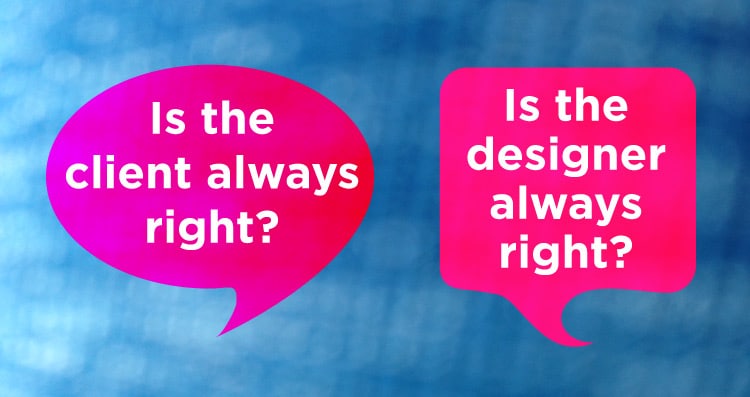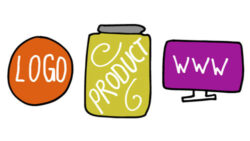Design is subjective—it’s going to resonate with people in different ways. Whether we like to admit it or not, personal preference always comes into play in one way or another.
I have had clients come to me after working with other designers or firms, lamenting things they didn’t like about these past experiences. In some instances, clients were provided with a design and if there was something the client wanted to change about it, they were told no. In other instances, the designers asked the clients to tell them what they wanted to see in the design, forcing the client to come up with the concept for the designer to execute as an order-taker.
This brings us to the question: Is the client always right, or is the designer always right?
Neither, actually. The middle ground is the sweet spot.
Design is very much a collaboration between the designer and the client. The client has lived the history of the business, running it, creating the products and nurturing their vision for where they want the business to go. The client brings this information to the relationship as a foundation for the work to be done together.
Where the designer comes into play is developing the packaging and branding that bridges the gap between where the client is now and where they want to be. Only by assessing the brand, product, target audience, consumer values, competitors and retail environment, can a design be strategically developed to get the client from Point A to Point B. The client needs someone who expertly knows their industry—best practices, what works and what doesn’t—to guide them to the right solution.
It is through this partnership and understanding of each party’s role that the creative process is fueled. Within that process, so much happens, often unexpectedly. This is what I love most about design: you don’t always know where the process is going to lead you. That is where the magic of collaboration comes alive.
At the beginning of a project, I may have a clear vision of what the end result will look like. But through the collaboration with the client, the concept morphs into something even better because it ends up being exactly what the client wants and needs, yet didn’t know they were looking for. Understanding each other and being open to new ideas allows this to happen.
From my experience working with a wide variety of clients over a long period of time, I can say with certainty that personal preference comes into play, and that’s okay—it’s part of the process. Sometimes a client may want to tweak a minor aspect of a design we develop. This might be shifting the hue of a color slightly, or changing a font style, to be more suitable their personal tastes. Whether it’s the owner of a boutique brand, or a key decision maker in a large corporation, there is always someone’s personal preference to meet. Unless there is a reason not to, incorporating these changes is a way for both sides to contribute to the end result.
Ultimately, if the client can’t get behind the concept 100% with enthusiasm, then it’s not a great concept. If there’s some aspect a client just can’t live with, we find a way to make it work for everyone—without sacrificing results.
It’s this partnership, this two-way street, that is the design process. When both sides understand this going into the relationship, amazing results happen.





I have heard this over the phone my friend! All great points that we look forward to implementing on the new website.
Regards
Guy Lopez
Thank you, Guy! Very much looking forward to your new website as well!
Hello Jenn,
I reached out last year. I can’t wait to be able to actually work with your company. Good article!
Likewise, Miasha! Would love to work with you on your pepper sauces!
Great article! I agree that collaboration and communication make the project even better.
Thanks, Deb! Exactly!
I have learned that the most important thing is to TREAT EACH OTHER RIGHT! Respect for each person’s rights is vital. It is never right when you think you are always right. There is always room to learn and hiring an engaging and professional designer like Jenn is the right thing to do to keep one in the right track! Blessings!
I fully agree, and thank you for your kind words, Marita! Loved doing the project with you, hope all is well.
BUT what happens when the client has no taste and wants something done to the design which to you seems inappropriate? As church organist, I have played many weddings. Back in the day, churches had rules (called “guidelines”) for appropriate music. I remember a bride that wanted Roberta Flack’s ‘The First Time Ever I Saw Your Face’ which was fine till we came to the second verse which began “The first time ever I slept with you….” We compromised–the song was sung but she and I sat down and changed the words of the second verse. Another client wanted a Disney Wedding and chose “Zip-a-dee-do-dah” as the wedding march. I agreed to play the melody if they would let me arrange it according to my taste. They agreed. So I gave it the big trumpet beginning, and then proceeded with the melody in bridal march style. Everyone loved it and especially because it was something of a euphemism. Just two months ago, I played a wedding where the bride requested NOT ‘Here comes the Bride’ , but rather “Here comes the Sun” by the Beatles. I found the sheet music on line, stuck to the chorus, played it on the keyboard with grandiose aplomb and everyone (grey hairs included) liked it. It’s not “selling out”…..It’s called collaborating with the client. The process often involves educating the client into the artistic world about which she or he probably has little insight. Go Jenn….and good luck!
Love hearing your musical collaboration experience, Martha! Fortunately I have a pretty good process to qualify my clients before we start working together to avoid such situations of bad taste coming into play. 🙂